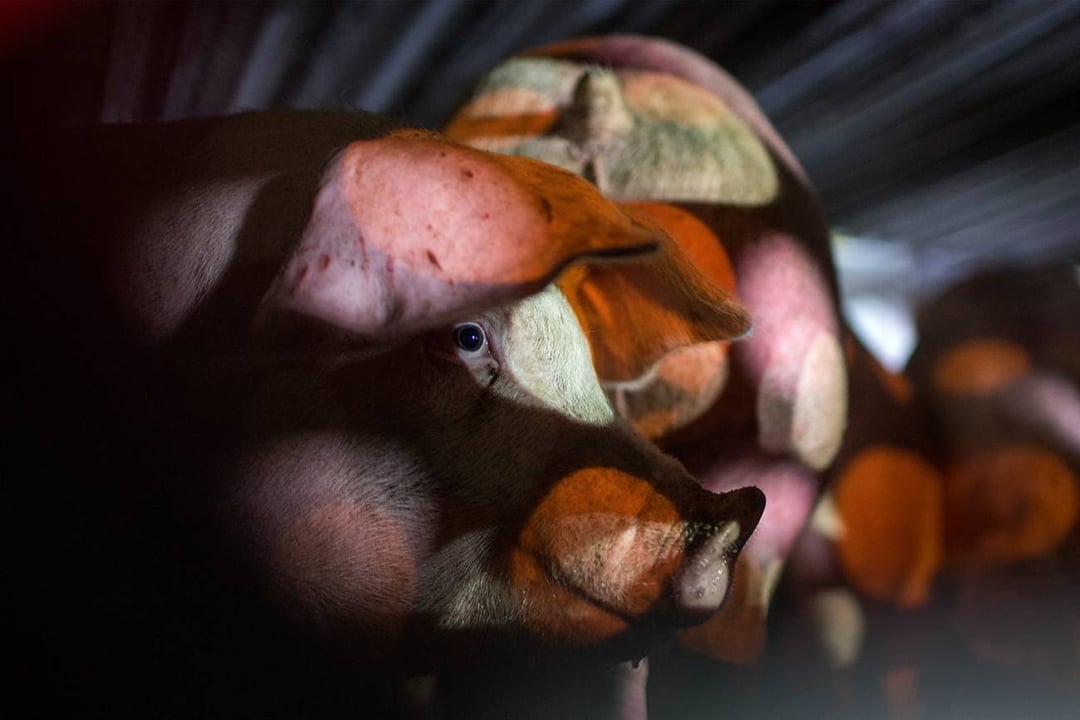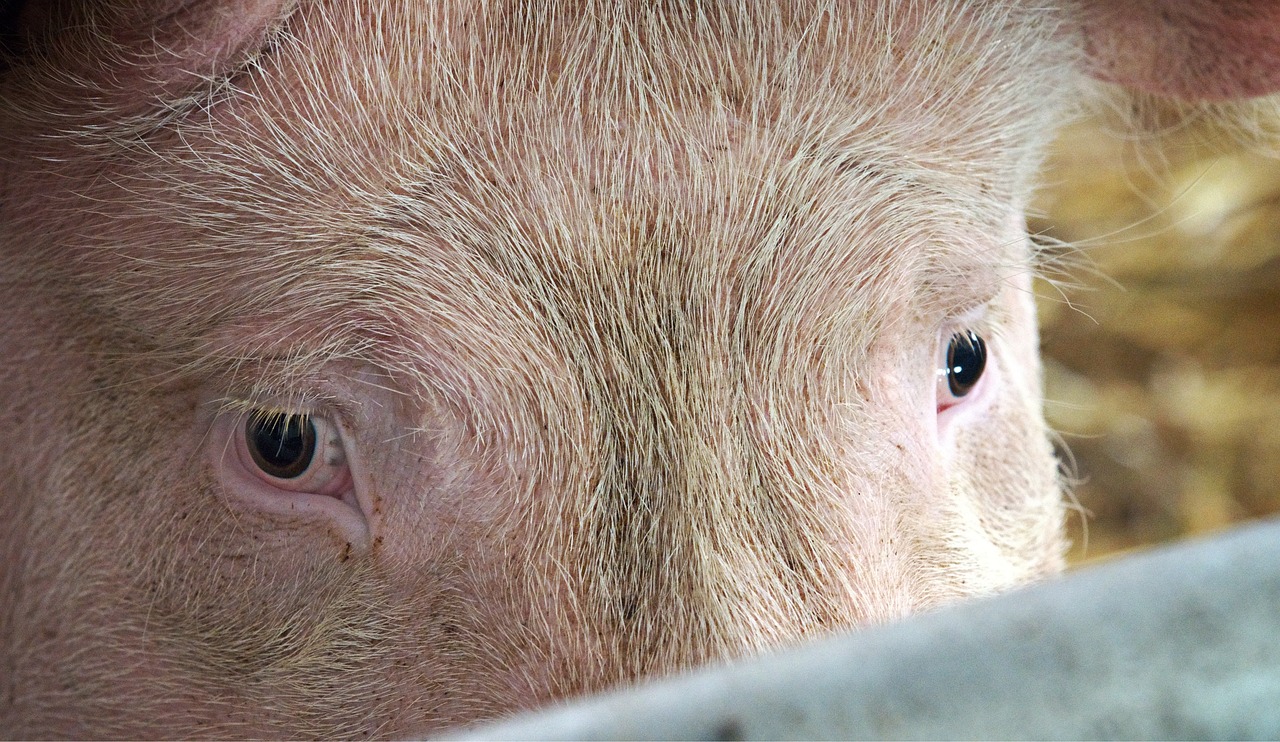

Pigs to the Slaughter
Leighton Woodhouse Dec 20, 2021
On April 15, 2020, four weeks after the first American city was locked down in response to the COVID-19 pandemic, a gruesome experiment was performed. The experimenters filled a trailer, specially fitted with heaters capable of bringing the temperatures inside to lethal levels, with pigs, and turned the heat on. The experimenters wanted to know how long it would take for the pigs to die. The answer, for some of them, was over an hour.
The test was designed to determine whether roasting pigs alive was an acceptable way to kill them. The result, for now, was no. The American Veterinary Medical Association’s standard for the acceptable mass extermination of livestock in an emergency situation is 95% mortality within an hour. The test had fallen slightly short of that marker, killing only 90% of the pigs in that time frame. So the experimenters decided to make the process even more “humane” by adding steam to the process.
Two days later, they conducted a second test in the same trailer, with another group of pigs. This time, the trailer was equipped with a steam generator. This did the trick: All of the pigs died inside of an hour. The pork industry now had their AVMA-approved method for mass killings of their surplus hogs.
The improvised death chamber was the pork industry’s solution to a crisis that had befallen the entire meat industry, across all its sectors. At slaughterhouses all over the country, workers were catching COVID-19 and being forced off the disassembly line.
For a little while, slaughterhouse operators had tried to ignore the problem. A worker for Tyson Foods in Arkansas who was hospitalized with COVID-19 told me about how workers at his poultry processing plant were expected to come in sick. Managers would lie about how many cases had broken out in the facility, he said; workers would be told there were fewer than 10, then go home and see on the evening news that there were hundreds. The company had put some safeguards in place at his plant to prevent the spread of the virus, but they were cosmetic. Partitions were put up between workers on the line, but not between workers standing directly across from each other. Employees had to pass through a temperature check scanner as they entered the building, but on weekends, nobody was there to pull workers off whose temperatures were too high. The machine would just keep beeping as sick, symptomatic workers walked inside. Meanwhile, behind the scenes, the meatpacking industry was lobbying the Trump administration to weaken the existing safety regulations for workers.
When workers developed cases of COVID that killed them or landed them in the hospital, leaving the plant short staffed, instead of slowing production, companies like Tyson just forced the remaining workers to work faster. In some facilities, line speeds were increased, thanks to a Trump administration waiver on line speed regulations, which made it even harder for workers to socially distance. A worker at a second Tyson plant told me that almost every employee there got COVID. He said he saw at least an accident a week as workers rushed to keep up production with inadequate staff. He saw one maintenance worker lose a finger while changing out a broken piece of machinery.
But the industry still couldn’t keep up with the COVID-induced labor shortage. Magaly Liccoli, the founder of Venceremos, a group that advocates for poultry workers, told me she had never in her career seen so many workers die in such a short period of time. In April, a single pig slaughterhouse in South Dakota was the biggest COVID-19 hot spot in the country. One study estimated that between meatpacking employees and the people they spread the virus to in the communities surrounding the plants, 6% to 8% of all COVID-19 cases in the U.S. originated in slaughterhouses. Eventually, so many workers got sick or died that slaughterhouses had to pause their operations, creating a glut of live animals in the supply chain. “The food supply chain is breaking,” Tyson’s chairman of the board wrote in a full-page New York Times ad.
By the time President Trump used the Defense Authorization Act to order slaughterhouses to reopen at the end of April, the swine slaughter industry was operating at just a little over 50% capacity. (Even after reopening shuttered plants, short staffing left the plants operating at severely reduced capacity.) This meant that hog farms, already facing reduced consumer demand due to restaurant closures, had hundreds of thousands of slaughter-ready animals with nowhere to go.
Pigs on factory farms are already so densely concentrated that they barely have space in their pens to move around. At the same time, the entire industrial process is designed to grow them as quickly as possible, through breeding, diet, and forced inactivity. With nowhere to send the pigs for slaughter, it was only a matter of days before they would outgrow the tiny spaces they were confined in. The industry needed a way to kill them all, and quickly.
Other, less excruciating methods were off the table. Factory farms claimed that they couldn’t obtain enough guns and ammunition, captive bolt guns and charges, carbon dioxide or electrocution equipment quickly enough to pursue any of the methods those tools imply. So after the success of the second test in the converted trailer, the industry adopted “ventilation shutdown,” as the method of overheating animals to death is known. Construction crews converted barns into giant makeshift ovens, their ventilation inlets and wall seams sealed, food and water removed, and heaters and steam generators affixed to them. In at least one case, the steam generator the farm used was designed for the railroad industry, to heat railcars.
For the animals themselves, it resulted in what the industry deceptively calls ‘euthanasia,’ but that is, in fact, in many cases an excruciatingly slow and torturous death.
It’s unclear how many pigs were killed this way. But nationally, at the end of April, when swine processing was down by 45%, according to one peer-reviewed paper, a quarter-million pigs per day who would have been sent to slaughter in normal times remained in their pens, awaiting some other end. As of June, when the industry began to bounce back, there were still 3.2 million such pigs. The National Pork Producers Council estimated that more than 10 million pigs exceeded the industry’s processing capacity from the end of June to mid-September. All those pigs were killed somehow, and if the industry is to be believed, ventilation shutdown was one of only a few feasible methods with which to do it (others included CO₂ gassing and slaughtering without processing the animals). An article written by five veterinarians on ventilation shutdown reports that at the single site they studied, nearly 250,000 pigs were roasted alive between April and June of 2020.
I’ve reported on animal exploitation extensively in the past, and specifically about Direct Action Everywhere, a Berkeley-based animal rights group. A couple of years ago, I formally joined the organization as a member. I don’t claim to be neutral when it comes to this issue, or this organization. I disclose this because DxE, as the group is abbreviated, is a big part of what happened next—and specifically, a DxE activist named Matt Johnson, whom I consider a personal friend.
Lucas Walker is a young, burly guy who voted for Trump and belongs to the NRA. Until recently, he was a truck driver for Iowa Select Farms, and looks the part. Walker grew up in the heart of pig farming country in Iowa and raises a few cows and pigs himself. But he found himself increasingly bothered by the casual abuse of pigs by overcrowding that he had seen every day on the job. Walker struggled with what to do about it. He knew there would be a backlash in his community, a town of just 6,000 people where the industry he was exposing constituted the entire local economy. “Big company, small town,” he said to me. The company’s COO lived just a mile and a half from his home.
Walker first learned about DxE when he watched a video that Matt Johnson had shot of the atrocious conditions on the hog farm of an Iowa state senator who had sponsored the state’s new “ag gag” law. In May, Walker sent an anonymous email to DxE to inform them about conditions at Iowa Select.
Walker wasn’t familiar with Matt Johnson, but his employer was. And some of the workers at Iowa Select Farms facilities soon would be, too. Later, when Johnson snuck onto an ISF farm, he found a flyer in the break room with his picture on it. The flyer said, “Si entra à la granja, nos carga la verga”: “If he gets on the farm, we’re fucked.”
Walker and Johnson struck up a dialogue. Walker told Johnson conditions at Iowa Select were far worse than on the state senator’s farm. Johnson was listening, but it was only after the pandemic began that the conversation really started to take shape. Johnson would ask Walker about the company’s ventilation shutdown plans—when and where were they happening—and Walker would go to work, strike up casual conversations with coworkers and find out. Then he’d pass it back to Johnson.
After having gathered logistical information from Walker, Johnson returned to Iowa. Along with a small team of activists, he staked out the facilities. “It was never a sure thing it was going to happen,” Johnson said. “Maybe a 50-50 chance.” But Johnson managed to sneak onto the barns that had been converted into VSD death chambers, and planted hidden cameras inside. The cameras captured hours of the agonizing extermination of hundreds of pigs, on both video and audio. Glenn Greenwald and I released the footage to the public.
The supply chain crisis that led to the implementation of ventilation shutdown was, in a sense, inevitable, given the structure of modern animal agriculture. Meatpacking is a classic economy of scale; large players are able to drive down their per-unit costs to such a degree that they can squeeze out smaller players, increasing their market share. Over the course of decades, the animal slaughter industry has become one of the most highly concentrated industries in the world. Eighty-five percent of beef packing in the United States is controlled by just four companies. In pork processing, 67% is controlled by the four largest firms; the number is 54% for chicken. Out of all of the high-volume pig slaughter in the country, nearly 90% of it is carried out by fewer than 30 slaughterhouses, each of which kill more than 1 million pigs per year.
That means that even a single one of those slaughterhouses coming offline can create a massive bottleneck across the industry. And in 2020, slaughter capacity was reduced by half, resulting in a supply chain backup of epic proportions. For consumers, that backup resulted in skyrocketing prices for meat. For the animals themselves, it resulted in what the industry deceptively calls “euthanasia,” but that is, in fact, in many cases an excruciatingly slow and torturous death.
In the aftermath of that crisis, the Biden administration has pledged to break up this hyperconcentration through antitrust enforcement, which could help control prices for consumers, create a fairer market for ranchers and livestock farmers and bring resilience to the supply chain in the event of another major disruption. A bill from Sen. Cory Booker and Rep. Ro Khanna, meanwhile, was recently introduced that would extend protections to meatpacking workers.
But for animals, there’s no relief on the horizon. Dr. Crystal Heath is a Berkeley-based veterinarian and a member of DxE (I count her, too, as a friend) who wants to make sure ventilation shutdown, or VSD, is never used again in future supply chain crises. She helped circulate an online petition under the name “Veterinarians Against Ventilation Shutdown,” which calls on the American Veterinary Medical Association to classify the practice as “not recommended.” She has about 3,500 veterinary professionals signed on, out of which about 1,500 are licensed veterinarians.
The request seems modest enough. But when the petition was submitted to the same effect to the AVMA House of Delegates, one delegate said that VSD needed to remain an option for the animal agriculture industry, in the likely event of another pandemic. Dr. Heath is worried that AVMA is setting the stage for allowing VSD to go forward in the future, in the event of another major supply chain disruption.
The AVMA’s scientific journal is the Journal of the American Veterinary Medical Association, or JAVMA. “JAVMA publishes stuff that’s nothing but supportive of VSD,” Dr. Heath said. “They’re saying we’re going to have to use it again, like it or not.”
JAVMA published the paper that described the results of the converted trailer experiment, and essentially endorsed the method. Responding to two letters to the editor in JAVMA that were critical of the practice, the researchers who conducted the converted trailer experiment accused their critics of putting veterinarians’ lives at risk. The researchers warned that “criticism from peers may have unintended negative effects on our colleagues,” referred to the “mental health crisis” within the profession and suggested that those who were advocating ending VSD might drive the veterinarians who helped implement it to suicide.
The status quo has persisted for slaughterhouse workers, as well. To date, an estimated 86,000 workers have caught COVID-19 and at least 423 have lost their lives to it. Today, fewer workers are getting sick because of the vaccines, but one poultry worker told me that at her plant, managers had learned from the pandemic that they can keep up the same pace of production with fewer workers. They never bothered hiring new staff to replace the workers they’d lost to COVID; they’re just pushing the remaining workers even harder. That’s led to fatigue and injury, which is a hazard to workers and animals alike. Whenever workers are pushed to the brink, animal welfare suffers too, as tired workers means less focused workers, and that can mean animals not being fully killed before they get through the kill line, which means they’re eviscerated while still alive.
The owners, however, have come out of the COVID supply chain crisis intact. Though livestock producers have been getting squeezed for decades by an evermore consolidated meatpacking industry, and the pandemic made it worse than ever, the government came to the aid of the producers who had exterminated their animals due to the slowdowns and closures of slaughterhouses. The USDA’s Pandemic Livestock Indemnity Program compensates pig, chicken, and turkey growers for 80% of their economic loss. Dr. Heath has calculated that the farm that carried out the converted trailer experiment likely received between $23 million and $34 million from the government for roasting its pigs alive.
And the giant meatpackers are doing better than ever before. Prices for meat are skyrocketing, with the lion’s share going to the packers. In fact, profits for meatpackers are so high that the Biden administration has accused the industry of “pandemic profiteering.”
But activists like Johnson remain a threat, so the meat industry is doing everything it can to destroy DxE. In June of 2020, local police and a private investigator for Iowa Select Farms identified Lucas Walker as DxE’s source. In a meeting that Iowa Select’s COO drove him to, the FBI tried to recruit Walker as an undercover informant against the activist group. An agent who interrogated Walker asked him if he knew if DxE sold drugs or guns to finance their activism, and asked Walker if he would be willing to sell drugs, too, in his role as an FBI spy. He asked him if he’d be willing to covertly record calls with Matt Johnson to help the FBI amass evidence against him. Walker turned him down.
In January, Johnson will be tried in Iowa for felony burglary, electronic eavesdropping, and “agricultural trespass.” (The last of those is part of the new ag gag law that was championed by the state senator whose hog farm Johnson infiltrated and filmed.) He says he looks forward to the trial, which he sees as an opportunity to further expose VSD to the light of day.
Walker’s only regret is that the company was able to spin the story as some shady act of sabotage carried out by some anonymous troublemaker, when in fact it was a respected senior employee of the company who had blown the whistle, as a matter of principle.
“When all is said and done,” Walker told me, “I wish I had been even more public about it.”



![[UPDATED] And the Bird Flu just keeps on coming… Bird Flu](https://zero-sum.org/wp-content/uploads/2024/05/The-bird-Flu-BW.jpg)
